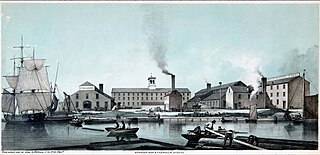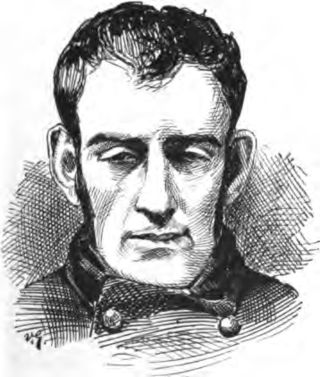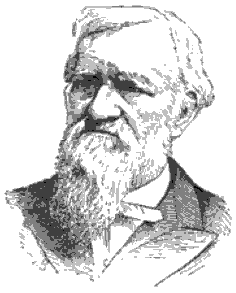Related Research Articles

M. Witmark & Sons was a leading publisher of sheet music for the United States "Tin Pan Alley" music industry.

The Gopher Gang was an early 20th-century New York street gang who counted among its members Goo Goo Knox, James "Biff" Ellison, and Owney Madden, born in England of Irish ancestry. Based in the Irish neighborhood of Hell's Kitchen, the Gopher Gang grew to control most of Manhattan with their territory covering Fourth to Forty-Second Street and Seventh to Eleventh Avenue.
Martin McBreen or Patrick Breen was an American saloonkeeper and criminal associate of the Gopher Gang. A well-known and colorful Hell's Kitchen figure known as Paddy the Priest, he was the owner of a Tenth Avenue saloon frequented by the Gophers and other underworld figures. Traditional accounts claim that McBreen was shot and killed by close friend and Gopher member John "Happy Jack" Mulraney. Mulraney had a facial disfigurement, caused by a partial paralysis of his face, which resembled a permanent "crooked-like" half smile. When McBreen asked why he did not smile on the other side of his face, Mulraney killed him over the perceived insult and robbed the till. When apprehended by police, Mulraney reportedly remarked to officers "I ain't smiling on either side of my face !". His murder was one of the first major trials during the first decade of the 20th century and, quoting then Governor William Sulzer, was one of the most violent to have occurred in the city's history.
James J. Corcoran was an Irish-born laborer and well-known personality among the Irish-American community of the historic "Corcoran's Roost" and the Kip's Bay districts, roughly the area near 40th Street and First Avenue in Manhattan, and was widely regarded as the champion of working-class Irish immigrants between 1850 and 1880.
Lewis "Lew" Baker was a Welsh-American patrolman in the New York Police Department who was simultaneously employed as a "slugger" for Tammany Hall. He was involved in voter intimidation and election fraud during the 1840s and 1850s. A close friend and associate of Irish mob boss John Morrissey, Baker frequently battled supporters of the nativist Know-Nothing movement for over a decade. He is most remembered however as the assassin of William "Bill the Butcher" Poole. Baker shot and killed Poole in a Broadway saloon during a brawl. Both Baker and Morrissey were placed on trial for murder, but were acquitted.
Annie Walsh, known under the pseudonym Battle Annie, was an American outlaw and member of the Gopher Gang. A well-known outlaw figure described in the press as "The Queen of Hell's Kitchen" and "the most feared brick hurler of her time", she was the founder and longtime leader of the gang's female auxiliary, the Lady Gophers, headquartered at Mallet Murphy's Battle Row saloon where they were officially known as the Battle Row Ladies' Social and Athletic Club. She was able to assemble a force from 50 up to several hundred women who, armed with clubs, were used as reserve members in gang fights against rival gangs and police. Walsh and her group were also hired out by businesses and labor unions throughout a number of violent labor disputes during the 1870s. She appears as a minor character in the 2003 historical novel A Passionate Girl by Thomas J. Fleming.

James "Wild Jimmy" Haggerty was an American criminal and well-known underworld mob figure in Philadelphia and later in New York City during the mid-to late 19th century. Jimmy Haggerty was the leader of the Schuylkill Rangers, a predominantly Irish-American street gang, which terrorized the South Philadelphia waterfront, specifically its local wharves and coal yards, for over 25 years.
Richard Joseph "Peg Leg" Lonergan was an American underworld figure and labor racketeer. He was a high-ranking member and the final leader of the White Hand Gang. He succeeded Bill Lovett after his murder in 1923 and, under his leadership, led a two-year campaign against Frankie Yale over the New York waterfront until he and five of his lieutenants were killed in South Brooklyn during a Christmas Day celebration at the Adonis Social Club in 1925.
Captain Isaiah Rynders was an American businessman, sportsman, underworld figure and political organizer for Tammany Hall. Founder of the Empire Club, a powerful political organization in New York during the mid-19th century, his "sluggers" committed voter intimidation and election fraud on behalf of Tammany Hall throughout the 1840s and 1850s before Tammany became an exclusively Irish-dominated institution.

Rosanna Peers (?-1840) was an American criminal fence and underworld figure in New York City during the early-to mid 19th century. She is the earliest known business owner to begin actively dealing with the city's emerging underworld and whose Centre Street grocery store and dive bar, established in 1825 just south of Anthony Street, was used as the longtime headquarters of the Forty Thieves upon their formation by Edward Coleman in 1826.
Charles P. Miller was an American gambler, confidence man and swindler. He was popularly known as "King of the Bunco Men", at times sharing that title with fellow tricksters Tom O'Brien and Joseph "Hungry Joe" Lewis, and ran one of the largest bunco operations in the United States during the late 19th century.

Michael "Sheeny Mike" Kurtz was an American burglar and gang leader in New York City during the mid-to late 19th century. He was one of the co-founders of the Dutch Mob, along with Little Freddie and Johnny Irving, during the 1870s. Kurtz and the others controlled the area between Houston and 5th Streets for several years until the gang was driven out by "strong-arm squads" under Captain Anthony Allaire in 1876. A year later he was arrested in Boston for robbing a silk house owned by Scott & Co. and sentenced to 12 years imprisonment. It was while in prison that he discovered that eating common soap could produce the effect of ill health. His sudden and unexplainable weight loss and other symptoms baffled the prison doctors and he was able to fool officials that he was dying and received a pardon.
Peter Sawyer was an American thief and robber in New York City during the 1860s. A native of California, Sawyer appeared in New York's Forth Ward and the waterfront in the years following the American Civil War. He is credited as being the first criminal to drug victims for the purposes of mugging them. Although sailors' homes and crimp houses had previously been using "knock-out drops" and "slipping mickeys" to shanghai sailors, Sawyer was the first to make effective use for armed robbery. At first, Sawyer used simple snuff which he dropped into the victim's alcohol but perfected the practice later on with chloral hydrate. This was the drug of choice, with exception to the occasional use of morphine, preferred by those who followed Sawyer in similar robberies. Indeed, the practice became so common in the city that these men were referred to as "Peter Players" by the police and underworld alike.
The Rhodes Gang was an American street gang based in New York City at the turn of the 20th century. The group was one of several smaller Hell's Kitchen gangs affiliated with the Gopher Gang, all of whom were almost constantly fighting among each other, among these including The Gorillas and the Parlor Mob. They were known, at times, to briefly put aside their differences when police attempted to interfere in gang fights and authorities found the area impossible to control.
Christopher Keyburn, commonly known by his alias Kit Burns, was an American sportsman, saloon keeper and underworld figure in New York City during the mid-to late 19th century, he and Tommy Hadden being the last-known leaders of the Dead Rabbits during the 1850s and 60s.
The Hole-in-the-Wall was a popular saloon and underworld hangout in what is now the South Street Seaport, Manhattan, New York City during the early- to mid-19th century. It has been described as the "most notorious" saloon in New York city during the 19th century. It was one of many dive bars and similar establishments in New York's infamous Fourth Ward, located at the corner of Water and Dover Streets. The saloon was owned by "One Armed" Charley Monell and featured notorious female criminals Kate Flannery and Gallus Mag as bouncers. Both women were employed by Monell as lieutenants in his local criminal organization, which included shanghaiing, and the latter woman supposedly kept a collection of human ears which she had bitten off from unruly customers in bar brawls. She displayed these as trophies on the bar in pickle jars. Sadie the Goat, the later leader of the Charlton Street Gang, was of the many victims who lost her ear in a brawl with Gallus Mag.
Frank Stephenson was an American saloon keeper and underworld figure in New York City during the mid-to late 19th century. He was the owner of The Black and Tan, a popular Bowery basement bar located on Bleecker Street. It was one of the first saloons to cater to African-Americans and was a competitor against neighboring establishments such as Harry Hill's gambling resort and Billy McGlory's Armory Hall among others. He is also credited for opening the city's first and oldest "undisguised" gay bar, The Slide, also on Bleecker Street.
"Big" Jack Poggi or Pioggi was an American saloon keeper and underworld figure in New York City at the start of the 20th century. His bar was the scene of a legendary gang fight in 1912.
Thomas Hadden was an American saloon keeper, criminal and underworld figure in New York City's infamous Fourth Ward during the mid-to late 19th century. He was the owner of a Cherry Street dive bar, a popular underworld hangout located next to Dan Kerrigan's place, and co-led the Dead Rabbits with Kit Burns. For over 25 years, his Water Street boarding house was one of the most notorious "crimp houses" on the New York waterfront as thousands of sailors were shanghaied, robbed or murdered. Hadden, and contemporaries such as Bill Slocum or John Allen, exercised considerable political influence in the city and were generally able to receive protection from city officials throughout their criminal careers.

Oliver Dyer was an American journalist, author, teacher, lawyer and stenographer. A pioneer in phonography, he developed his own shorthand system which was the first to be adopted for use in the United States. It was used not only for courtroom testimony but also for recording political events such as the Free Soil Convention in Buffalo, New York, and sessions of the 30th United States Congress in Washington, D.C., in 1848. It was in the latter role that he became the first Congressional shorthand reporter.
References
- ↑ Asbury, Herbert. The Gangs of New York: An Informal History of the New York Underworld. New York: Alfred A. Knopf, 1928. (pg. 235) ISBN 1-56025-275-8
- ↑ Witmark, Isidore. The Story of the House of Witmark - From Ragtime to Swingtime. New York: Lee Furman, Inc., 1939. (pg. 43)
- ↑ Federal Writers' Project. New York City: Vol 1, New York City Guide. Vol. I. American Guide Series. New York: Random House, 1939. (pg. 156)
- ↑ Marcuse, Maxwell F. This Was New York!: A Nostalgic Picture of Gotham in the Gaslight Era. New York: LIM Press, 1969. pg. 63)
- ↑ English, T.J. Paddy Whacked: The Untold Story of the Irish American Gangster. New York: HarperCollins, 2005. (pg. 116) ISBN 0-06-059002-5